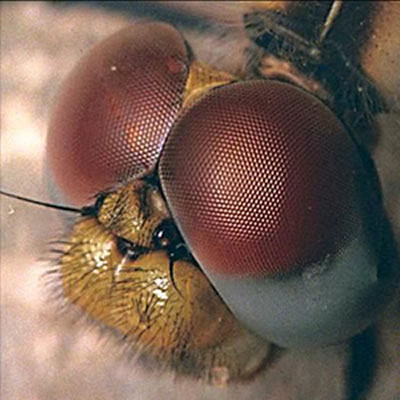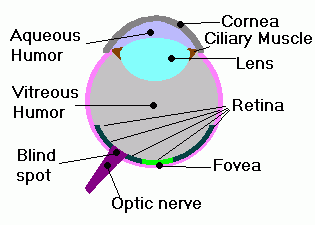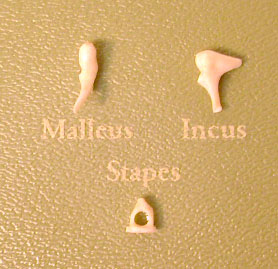Mechanoreceptors are receptors stimulated by physical stimuli, such as pressure, touch, stretch, motion, or sound
Thermoreceptors respond to either heat or cold and help maintain body temperature by keeping the core temperature stable.
Chemoreceptors transmit information about solute concentration in a solution. Gustatory (taste) receptors and olfactory (smell) receptors are two types of chemoreceptors.
Photoreceptors and Vision

Compound Eyes (in insects and crustaceans) consist of up to several thousand light detectors called ommatidia, each of which has its own lens.
Single-lens eyes are found in vertebrates and some invertebrates.
 The eyeball in single-lens eyes is made up of two outer layers, the sclera (which in the front of the eye is the cornea-responsible for acting as a lens) and the choroid. The eyeball also contains the pupil, which is the hole in the center of the iris, and the retina, which contains the photoreceptor cells.
The eyeball in single-lens eyes is made up of two outer layers, the sclera (which in the front of the eye is the cornea-responsible for acting as a lens) and the choroid. The eyeball also contains the pupil, which is the hole in the center of the iris, and the retina, which contains the photoreceptor cells.The sclera is an extension of the cornea.
Aqueous humor fills the anterior cavity of the eye, and the vitreous humor fills the posterior cavity of the eye.
The retina contains rod cells and cone cells, two types of photoreceptors.
Rhodopsin is the light-absorbing pigment that triggers a signal transduction pathway that ultimately leads to sight.
Identify the part of a single-lens eye with this link:
http://courses.washington.edu/chordate/453photos/skull_photos/human_ear_ossicles.jpg
Hearing and Equilibrium
There are three regions in the mammalian ear.
 1. The outer ear, which is the external pinna and auditory canal. These collect sounds and bring them to the tympanic membrane (eardrum), which separates the outer ear from the middle ear.
1. The outer ear, which is the external pinna and auditory canal. These collect sounds and bring them to the tympanic membrane (eardrum), which separates the outer ear from the middle ear.2. The middle ear, in which vibrations are conducted through three small bones collectively called ossicles
 (individually, the malleus, incus, and stapes) and through the oval window.
(individually, the malleus, incus, and stapes) and through the oval window.3. Then the vibrations are conducted to the inner ear, which consists of a labyrinth of channels lined by membrane and containing fluid, all situated in bone.
The inner ear contains the cochlea, a two-chambered organ, which is involved in hearing.
The organ of Corti, which is in the cochlea, contains the receptors of the ear, which are hair cells with hairs that project into the cochlear duct.
The cochlea transduces the energy of the vibrating fluid into action potentials, in a wave that dissipates at the round window.
Some organs in the inner ear are responsible for detecting body position and balance. These are the semicircular canals.
~Quick Quiz~
1. The Ossicles in the ear contain three bones. What are they called?
a. the malleus, incus, and staple
b. the incas, mallus, and stapes
c. the malleus, incus, and stapes
d. the stepes, incas, and mallous
2. What part of the ear gives us balance?
a. semicircular canal
b. the pinna
c. the malleus
d. the incus
3. Which part of the eye reacts to color?
a. cornea
b. rod cell
c. rhodopsin
d. cone cell
answers: c,a,d
No comments:
Post a Comment